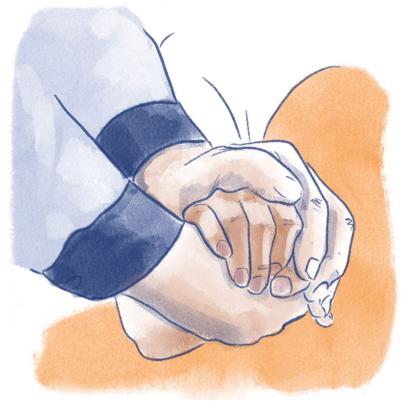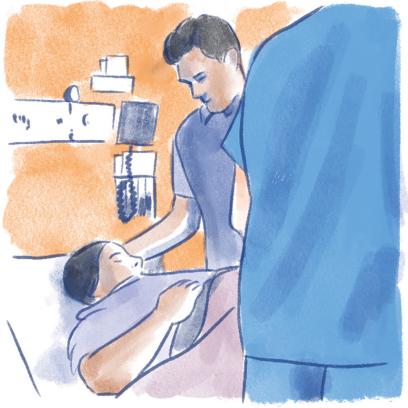As the United States contends with a pivotal moment of reckoning on racial justice, inequitable treatment in healthcare has risen in the public consciousness1—largely due to the disproportionately high rates of COVID-19 among Black Americans and other communities of color.2 Behind the statistics are personal stories of people of color, across geography, socioeconomic status, and health profile, who have been denied access to lifesaving care, even as their expressions of pain, discomfort, and illness have been ignored. For those of us working in health equity and who have studied the history of mistreatment of marginalized communities by the medical establishment, hearing and seeing these stories play out in the context of COVID-19 is not surprising. As devastating as these stories are, the commonalities are always Black and brown skin, mistreatment, and, far too often, premature death.3
Similarities can be seen in trends related to America’s maternal health crisis. Black and Native women are dying at alarmingly high rates due to preventable pregnancy-related causes. According to the Centers for Disease Control and Prevention, non-Hispanic Black women are approximately three times more likely to experience maternal death than white women.4 Native American and Alaska Native women are approximately two times more likely to die than white women. (This is in stark contrast to Hispanic, Latina, Asian, and Pacific Islander women, whose rates are quite similar to white women’s.) Most of these deaths are preventable and occur not just during delivery but up to a year after giving birth. Black women also have a 70 percent greater risk of experiencing severe maternal morbidity than white women.5
COVID-19 has made maternal health matters even worse. Based on preliminary data, pregnant women who fall ill due to COVID-19 are more likely to be admitted to the intensive care unit and receive invasive ventilation, and they are at increased risk of death compared with nonpregnant women. Black and Hispanic pregnant women are disproportionately likely to experience grave illness and complications due to COVID-19.6
Racial health disparities like these do not exist in a vacuum. Research has long shown that social determinants—such as the degree to which people can access affordable, safe housing and nutritious foods and whether they experience residential segregation, economic disadvantage, or exposure to environmental toxins—are important factors that practically dictate a person’s health and well-being.7 Access to quality, respectful healthcare that is free of discrimination and bias is also critically important. Unfortunately, discrimination and bias based on race and gender have pervaded the healthcare experiences of women of color in the United States for centuries.
Medical Mistreatment of Black and Native Women
The medical mistreatment of Black and Native women is not a new phenomenon; it has been widespread since before our nation’s founding. For Black women, it can be traced as far back as the institution of slavery, when Black women’s bodies were used without consent for experimentation in the study of obstetrics and gynecology.8 Slave owners actively sought the assistance of physicians in the management of Black women’s fertility. Particularly after the ban on importing enslaved people in 1808, slave owners had financial incentives to force enslaved women to have as many children as possible. Enslavers became familiar with new training practices and surgical procedures for reproductive organs developed by medical doctors by the mid-19th century. Coerced “breeding” of and medical experimentation on enslaved people were commonplace.9
Enslaved Black women were subjected to painful and injurious experimental surgeries on their reproductive organs. They were cut open and prodded with all types of surgical instruments without consent. It was during this period that falsehoods about Black people having “thicker skin” and a higher threshold for pain were first spread.10 While anesthesia was not used in most cases, morphine was sometimes used to drug enslaved Black women in order to make them docile and to reduce the screams that came with undergoing invasive vaginal surgeries.11 Some became morphine dependent as a result.
A doctor named Nathan Bozeman gained renown as a gynecologic surgeon due to his operations on enslaved Black women in Alabama. One 18-year-old enslaved girl became disabled and was rendered sterile as the result of one of his experimental surgeries,12 but his disregard for enslaved women’s humanity seems to have had no impact on his reputation.13 One need not look far to also learn of J. Marion Sims, known as the father of modern gynecology, a medical pioneer who employed harsh practices to restrain enslaved Black women during the repeated invasive gynecologic surgeries he conducted on them.14
It should be noted that the experimental procedures and drugs developed during this time period served to advance the study of gynecology in ways that would ultimately heal white women of most of their reproductive injuries and illnesses. But for women of color, these advances have too often been used to harm, not heal, as scientific advances have led to further exploitation. Decades after Bozeman and Sims partnered with enslavers, the end of slavery shifted the focus from expanding the enslaved Black population to minimizing the free Black population. Under the guise of the pseudoscience of eugenics—the pursuit of perfection of the (white) human race through controlling the reproduction of people perceived to be physically, intellectually, or morally “unfit”15—compulsory sterilization began to be used as a form of reproductive control over women of color and low-income women.16 Black and Native American women have been the main targets of this horrific practice.
In the 1970s, extremely large numbers of Native American women suffered sterilizations* against their will.18 Many of the forced sterilization procedures were performed by physicians associated with the Indian Health Service (IHS). For example, Native American girls as young as 15 years old entered an IHS hospital in Montana for appendectomies and instead received tubal ligations without their knowledge or consent. Their parents were also not informed of the procedures. The IHS would eventually be accused of sterilizing at least 25 percent of Native American women of reproductive age during the 1970s.19
Meanwhile, Black women were also being forcibly sterilized in the southern and northern regions of the United States. In 1972, the Boston Globe reported that Boston City Hospital was conducting hysterectomies on Black patients at high rates.20 Other incidents were reported at a New York municipal hospital where low-income Black, Puerto Rican, and Native American women were targeted and given hysterectomies against their will. The procedure was so common in the South that it was referred to by the name “Mississippi appendectomy”—a term coined by civil rights leader Fannie Lou Hamer, who had undergone a forced sterilization herself.21 At the time, hospitals had no policies requiring informed consent.
Forced sterilizations of women of color are still occurring in the United States. As recently as September 2020, multiple people came forward with allegations that women in the custody of a US Immigration and Customs Enforcement facility in Georgia were being sterilized without their consent.22
Medical mistreatment by way of nonconsensual experimental surgeries and forced sterilizations added to the centuries-long history of exploitation of Black and Native women. These experiences have caused some people of color to mistrust the medical establishment, which can make patients less likely to seek care when they need it. Even when people of color do seek care, they may not engage in dialogue about treatment plans or other healthcare issues in clinical settings. The lack of respectful care has persisted, leading to inferior treatment, misperceptions about the pain thresholds of women of color,† and poor health outcomes.24 And while the medical experiences of the majority of women of color are safe and under the care of qualified physicians, nurses, and other healthcare professionals, discrimination and bias persist in ways that continue to have detrimental impacts.25 These detrimental impacts have consequences for the maternity care women of color receive and the likelihood of Black and Native women experiencing pregnancy-related complications and death.
Respectful Maternity Care
Acknowledging the basic human rights of pregnant women and other pregnant and birthing people, such as transgender, nonbinary, and intersex people (who face compounded barriers to accessing quality healthcare and birthing and parenting with dignity), is an imperative to realizing respectful maternity care for all. These basic rights envelop bodily autonomy, dignity, feelings, choices, and personal preferences in the provision of care.26 Too often, healthcare providers focus solely on bodily safety and disease prevention. These are important, but respectful maternity care denotes the importance of thinking more broadly to intentionally center the most marginalized among us in order to address the higher rates of maternal mortality and morbidity among certain populations. Centering the most marginalized people also creates space for empathy and consideration of lived experience in how pregnant and birthing people are treated in medical settings.
Women across racial and ethnic groups feel discriminated against in healthcare settings.27 However, the intersection of race and gender for women of color means that multiple oppressions pervade their healthcare experiences (past and present) in ways that are quite different from the experiences of white women. The result often leads to feelings of invisibility and not being listened to by healthcare providers when expressions of pain and discomfort are made before, during, or after birth, as well as in the postpartum period. At times, it leads to poor maternal health outcomes and even death.
Ignoring Black women’s pain in particular, which is grounded in racist stereotypes about how Black people feel and experience pain, has been highlighted as a factor in countless maternal health stories. Some of these include the stories of celebrities such as Serena Williams, who experienced complications after giving birth by cesarean section. Despite being a top athlete who is clearly in tune with her body and knowledgeable about her medical issues, she had challenges obtaining responsive postpartum care once she informed her healthcare team that she was experiencing shortness of breath. Williams also told them that she was worried about her health due to a history of experiencing blood clots.28 Other stories are those of everyday Black women who succumbed to their complications after multiple requests for help, such as Dr. Shalon Irving, Kira Johnson, Amber Isaac, and a host of others (see “Medical Mistreatment Today: Three Stories” to the right).
Access to timely, quality healthcare can help identify, manage, and treat health conditions that complicate pregnancy, can reduce the risk of poor health outcomes, and can reduce rates of maternal mortality and morbidity. While issues such as continuous perinatal support and health insurance coverage are important, so too is the ability to obtain respectful care. Recently developed evidence-based maternity care models offer guidance for healthcare providers who are ready to examine their practices.
The JJ Way, created by Black British-trained midwife Jennie Joseph, is a maternity care model that centers the agency and choices of pregnant people by including them as partners in their own care team. To increase access to care, no one is turned away from its clinics based on lack of insurance coverage or the inability to pay. The JJ Way provides assistance in navigating the healthcare system along with personalized care plans that are practical and based on each individual’s lived experiences. These are all fundamental aspects of centering pregnant and birthing people in healthcare. A recent evaluation in Florida demonstrated that women who received maternity care through the JJ Way had lower preterm birth rates and better low-birth-weight outcomes than the general state population. Furthermore, among at-risk populations, low birth weights were greatly reduced and preterm birth disparities were eliminated.29
Mamatoto Village, a Black woman–led nongovernmental organization based in Washington, DC, also implements a model of care that centers the patients and their lived experiences. Patients served by Mamatoto Village receive comprehensive, culturally responsive services, including classes on childbirth, breastfeeding, and family wellness; access to community birth workers (whom Mamatoto also trains); and connections to family support resources. In 2017, a review of women served by Mamatoto Village found that 74 percent had vaginal births (more than 10 points higher than the citywide percentage), 89 percent succeeded in breastfeeding (6 points higher than citywide), and 92 percent attended their six-week postpartum appointment. Best of all, there were no maternal or infant losses among those who received care under Mamatoto’s model.30
These models center pregnant and birthing people and their families by offering enhanced support from pregnancy through the postpartum period. Continuity of care is promoted by centralizing referrals for needed healthcare services, and concerted efforts are made to facilitate navigation of the health system and social services.31 Patients under the care of these models also have the support of a team that includes physicians and nurses as well as doulas, postpartum care navigators, community health workers, and midwives. Ensuring racial and economic diversity within the care team is key because research demonstrates that it leads to better health outcomes for women and infants of color.32 The team works collaboratively among themselves and with each patient to ensure optimal care and support that is grounded in cultural humility‡ and centers the lived experiences of the individuals and families being served.33
Where We Go from Here
The provision of respectful maternity care must be implemented broadly in order to ensure quality healthcare experiences and positive maternal health outcomes for all pregnant and birthing people. Black and Native women stand to gain the most under maternity care models that center the unique lived experiences of people of color and are intentional about ensuring a diverse care team that reflects their communities—those most heavily impacted by maternal mortality and morbidity. Care teams should consist of physicians, nurses, doulas, midwives, and community health workers. They must be adequately trained in cultural humility and antiracism so that they can approach each patient with a genuine interest in listening and learning. They must also be held accountable for providing pregnant and birthing people with quality care that is equitable and free from bias and discrimination.
In addressing America’s maternal health crisis, the unique and profound history of medical mistreatment toward Black and Native women must not go unacknowledged. It is no coincidence that these women are among the most subjugated in this country. The blatant racism and sexism inherent in the past barbaric practices of exploitation, experimentation, and forced sterilizations have implications for today’s maternal health outcomes. Devaluation of these women because of their race led to ignoring their pain and discomfort, as well as a lack of respect for their basic human rights. Unfortunately, devaluation still pervades the healthcare system today, leading to needless pregnancy-related deaths and complications. The devaluation of Black and Native women must be dismantled in order to improve the nation’s maternal health outcomes, as well as the poor health outcomes we see mirrored along racial lines in the COVID-19 crisis. It starts with healthcare providers who commit to doing the work to rid themselves and their institutions of bias and racism toward women of color.
Jamila K. Taylor, PhD, the director of healthcare reform and a senior fellow at The Century Foundation, leads research and policy efforts to achieve universal coverage and high-quality care. Taylor’s specialties are maternal health, reproductive justice, structural barriers to healthcare, racial and gender disparities in health outcomes, and the intersections of health and economic justice. Taylor also chairs the board of directors of Mamatoto Village.
*This is just one example in the long history of denial and abuse of reproductive freedom for Native women in the United States, which has seen the same kinds of seemingly contradictory pendulum swings as the history of assaults on Black women’s reproductive freedoms. For instance, as the US government shifted from genocidal practices against Native peoples to forced assimilation, the Bureau of Indian Affairs pressured Native Americans to adopt Euro-American reproductive and birthing practices—including coercing Native women to carry every pregnancy to term, despite some Native peoples’ traditional use of abortion for family planning.17 (return to article)
†Beginning in the 18th century, in keeping with their myths about Black women, white doctors promoted the myth that Indigenous women experience less pain than white women during childbirth because of their proximity to nature.23 (return to article)
‡Cultural humility is the ability to have an interpersonal viewpoint that is open to those with different cultural backgrounds. It focuses on a lifelong commitment to self-evaluation and self-critique by acknowledging that learning and commitment to embracing cultural differences are continual. (return to article)
Endnotes
1. See, for example, E. Brochin, “Racism and Public Health—a New Announcement, a Growing Understanding,” Massachusetts Association of Community Development Corporations, July 10, 2020, macdc.org/news/racism-and-public-health-%E2%80%93-new-announcement-growing-understanding.
2. K. Mackey et al., “Racial and Ethnic Disparities in COVID-19–Related Infections, Hospitalizations, and Deaths: A Systematic Review,” Annals of Internal Medicine, December 1, 2020.
3. M. Rees, “Racism in Healthcare: What You Need to Know,” Medical News Today, September 16, 2020, medicalnewstoday.com/articles/racism-in-healthcare.
4. Centers for Disease Control and Prevention, “Pregnancy-Related Mortality Ratio by Race/Ethnicity: 2014–2017,” Pregnancy Mortality Surveillance System, cdc.gov/reproductivehealth/maternal-mortality/pregnancy-mortality-surveillance-system.htm.
5. K. Liese et al., “Racial and Ethnic Disparities in Severe Maternal Morbidity in the United States,” Journal of Racial and Ethnic Health Disparities 6, no. 4 (August 2019): 790–98.
6. S. Ellington et al., “Characteristics of Women of Reproductive Age with Laboratory-Confirmed SARS-CoV-2 Infection by Pregnancy Status—United States, January 22–June 7, 2020,” Morbidity and Mortality Weekly Report, Centers for Disease Control and Prevention, cdc.gov/mmwr/volumes/69/wr/mm6925a1.htm?s_cid=mm6925a1_w.
7. Office of Disease Prevention and Health Promotion, U.S. Department of Health and Human Services, “Determinants of Health,” healthypeople.gov/2020/about/foundation-health-measures/Determinants-of-Health#social.
8. D. Owens and S. Fett, “Black Maternal and Infant Health: Historical Legacies of Slavery,” American Journal of Public Health 109, no. 10 (October 2019): 1342–45.
9. J. Taylor, “Structural Racism and Maternal Health Among Black Women,” Journal of Law, Medicine & Ethics 48, no. 3 (2020): 506–17.
10. K. Hoffman et al., “Racial Bias in Pain Assessment and Treatment Recommendations, and False Beliefs About Biological Differences Between Blacks and Whites,” Proceedings of the National Academy of Sciences 113, no. 16 (April 19, 2016): 4296–4301.
11. Taylor, “Structural Racism.”
12. Taylor, “Structural Racism.”
13. N. Bozeman, “Nathan Bozeman,” in American Medical Biographies, ed. H. Kelly and W. Burrage (Baltimore: Norman, Remington Company, 1920), en.wikisource.org/wiki/American_Medical_Biographies/Bozeman,_Nathan.
14. Taylor, “Structural Racism.”
15. K. Norrgard, “Human Testing, the Eugenics Movement, and IRBs,” Nature Education 1, no. 1 (2008): 170.
16. Norrgard, “Human Testing.”
17. B. Theobald, Reproduction on the Reservation: Pregnancy, Childbirth, and Colonialism in the Long Twentieth Century (Chapel Hill: University of North Carolina Press, 2019), 39–41.
18. J. Lawrence, “The Indian Health Service and the Sterilization of Native American Women,” American Indian Quarterly 24, no. 3 (Summer 2000): 400–19.
19. Lawrence, “The Indian Health Service.”
20. Taylor, “Structural Racism.”
21. D. Roberts, Killing the Black Body: Race, Reproduction, and the Meaning of Liberty (New York: Vintage Books, 1998), 90–92.
22. N. Narea, “The Outcry over ICE and Hysterectomies, Explained,” Vox, September 18, 2020, vox.com/policy-and-politics/2020/9/15/21437805/whistleblower-hysterectomies-nurse-irwin-ice; see also P. Nicolas and M. Fabiszak, “Forced Hysterectomies in 2020: How Did We Get Here?,” Globe Post, October 20, 2020, theglobepost.com/2020/10/20/forced-hysterectomies-2020.
23. Theobald, Reproduction on the Reservation, 34–35.
24. Hoffman et al., “Racial Bias.”
25. D. Williams and T. Rucker, “Understanding and Addressing Racial Disparities in Health Care,” Health Care Financing Review 21, no. 4 (Summer 2000): 75–90.
26. “Respectful Maternity Care: The Universal Rights of Childbearing Women,” White Ribbon Alliance, January 2012, who.int/woman_child_accountability/ierg/reports/2012_01S_Respectful_Maternity_Care_Charter_The_Universal_Rights_of_Childbearing_Women.pdf.
27. J. Taylor et al., “Eliminating Racial Disparities in Maternal and Infant Mortality: A Comprehensive Policy Blueprint,” Center for American Progress, May 2, 2019, americanprogress.org/issues/women/reports/2019/05/02/469186/eliminating-racial-disparities-maternal-infant-mortality.
28. R. Haskell, “Serena Williams on Motherhood, Marriage, and Making Her Comeback,” Vogue, January 10, 2018, vogue.com/article/serena-williams-vogue-cover-interview-february-2018.
29. Taylor et al., “Eliminating Racial Disparities.”
30. Taylor et al., “Eliminating Racial Disparities.”
31. J. Taylor, “Promoting Better Maternal Health Outcomes by Closing the Medicaid Postpartum Coverage Gap,” The Century Foundation, November 16, 2020, tcf.org/content/report/promoting-better-maternal-health-outcomes-closing-medicaid-postpartum-coverage-gap.
32. T. Chalhoub and K. Rimar, “The Health Care System and Racial Disparities in Maternal Mortality,” Center for American Progress, May 10, 2018, americanprogress.org/issues/women/reports/2018/05/10/450577/health-care-system-racial-disparities-maternal-mortality.
33. A. Waters and L. Asbill, “Reflections on Cultural Humility,” CYF News, American Psychological Association, August 2013, apa.org/pi/families/resources/newsletter/2013/08/cultural-humility; and C. Sakala et al., Improving Our Maternity Care Now (Washington, DC: National Partnership for Women and Families, September 2020), nationalpartnership.org/our-work/resources/health-care/maternity/improving-our-maternity-care-now.pdf.
[Illustrations by Gabriella Trujillo]




